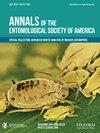农业生态系统中的营养景观:关于资源和管理做法如何影响农业环境中传粉媒介健康的综述
IF 1.8
3区 农林科学
Q1 ENTOMOLOGY
引用次数: 0
摘要
传粉者的营养是一个高度复杂的主题,我们刚刚开始解开,从蜜蜂饲料(花粉和花蜜)的多维性质到非生物环境如何影响蜜蜂可用的资源。这样做是至关重要的,因为改善传粉媒介资源的可用性和营养是改善种群和传粉媒介健康的拟议机制之一。然而,景观变化改变了传粉媒介的自然资源。农田和种植系统为传粉者创造了独特的营养景观,农业生态系统通常包含很少的作物,以及包含非作物植物的自然走廊。种植的作物类型和周围的景观将最终影响蜜蜂获得的营养景观。甚至农业的管理做法和控制害虫的方式也会直接或间接地影响蜜蜂的健康和营养。因此,有必要更好地了解农业生态系统中的蜜蜂营养。本文综述了蜜蜂营养生态学和农业景观的研究进展,以促进我们对农业中蜜蜂健康的认识。图形抽象本文章由计算机程序翻译,如有差异,请以英文原文为准。
The nutritional landscape in agroecosystems: a review on how resources and management practices can shape pollinator health in agricultural environments
Pollinator nutrition is a highly complex subject that we are just starting to unravel, from the multidimensional nature of bee forage (pollen and nectar) to how the abiotic environment can affect the resources available to bees. Doing so is of utmost importance, as improving pollinator resource availability and nutrition is one of the proposed mechanisms to improve populations and pollinator health. However, landscape change has changed the resources naturally available for pollinators. Farmland and cropping systems create a unique nutritional landscape for pollinators, with agroecosystems typically containing few crops dominating a landscape along with natural corridors containing noncrop plants. The types of crops planted and the surrounding landscape will ultimately affect the nutritional landscape bees have access to. Even the management practices in agriculture and how pests are controlled will, directly and indirectly, affect bee health and nutrition. Hence, a better understanding of bee nutrition in agricultural ecosystems is warranted. This review synthesizes research on bee nutritional ecology and the agricultural landscapes to advance our understanding of bee health in agriculture. Graphical Abstract
求助全文
通过发布文献求助,成功后即可免费获取论文全文。
去求助
来源期刊
CiteScore
4.90
自引率
0.00%
发文量
25
审稿时长
6-12 weeks
期刊介绍:
The Annals of the Entomological Society of America exists to stimulate interdisciplinary dialogue across the entomological disciplines and to advance cooperative interaction among diverse groups of entomologists. It seeks to attract and publish cutting-edge research, reviews, collections of articles on a common topic of broad interest, and discussion of topics with national or international importance. We especially welcome articles covering developing areas of research, controversial issues or debate, and topics of importance to society. Manuscripts that are primarily reports of new species, methodology, pest management, or the biology of single species generally will be referred to other journals of the ESA. The most important criteria for acceptance are quality of work and breadth of interest to the readership.

 求助内容:
求助内容: 应助结果提醒方式:
应助结果提醒方式:


